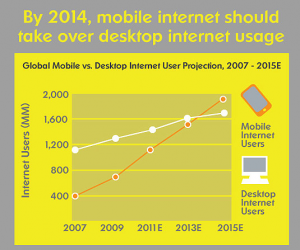Mobile Device Takeover: Part 1 – Integrating Mobile into Your Digital Strategy
 The focus on mobile advertising has exploded this year. New marketing jargon is being tossed around board rooms, blogs, and industry news sites like “mobile ecosystem”, “mobile marketing”, and “m-commerce” (a clever mix between mobile and e-commerce). Even Google has jumped the gun this year by requiring every AdWords campaign to automatically bid on mobile ads unless otherwise adjusted. While the world is just beginning to scratch the surface of mobile marketing potential, it is important that you understand what you should be doing right now (part 1), and things you will need to consider for the future (part 2).
The focus on mobile advertising has exploded this year. New marketing jargon is being tossed around board rooms, blogs, and industry news sites like “mobile ecosystem”, “mobile marketing”, and “m-commerce” (a clever mix between mobile and e-commerce). Even Google has jumped the gun this year by requiring every AdWords campaign to automatically bid on mobile ads unless otherwise adjusted. While the world is just beginning to scratch the surface of mobile marketing potential, it is important that you understand what you should be doing right now (part 1), and things you will need to consider for the future (part 2).
Things you need to do right now:
1.Keep an eye on how many mobile users are visiting your site in Google Analytics
The first step in evolving your mobile strategy is to see what kind of mobile action your website is getting. The easiest way to do this is to keep and eye on mobile site traffic. If you are noticing that you are receiving a large number of mobile visitors, then you should consider adopting your current marketing strategies to include a mobile strategy.
Understanding mobile traffic will help guide your bids in Google AdWords for mobile devices. As mentioned previously, Google has integrated mobile and desktop bidding together, and mobile bids must now be manually adjusted. Determining the right amount of budget to allocate to mobile devices can be based on the percentage of mobile traffic your site receives, or various other caveats outline by your marketing team.
2. Figure out if mobile marketing fits with your company
Like any marketing strategy, alignment to your company’s brand and goals is very important. However, because of the size, speed, and clarity of newer generation smart phones, there are very few companies who can say they don’t need to invest in mobile marketing. To determine if mobile marketing is a good fit for your organization, I suggest experimenting with mobile ads in your Google AdWords account. By testing mobile ads, you can easily determine if qualified leads or conversations are being generated on mobile devices. If you are getting good traffic to your site via mobile, it may be time to consider more ways to leverage this platform.
3. Make your website mobile friendly
There are so many reasons to adapt your current website to the mobile environment and as more people around the world are gaining access to the internet via their cell phones, it is important that your website can properly serve this mobile audience. Even from an SEM and SEO perspective it makes sense to have a mobile site. Recently, Google announced it will be penalizing web addresses in the mobile search engine that are not mobile friendly. This is aligned with their strategy to deliver the best user experience possible to Google searches. There are three different ways to adapt your desktop site to the mobile environment; create a mobilized site (like m.vovia.com), have a responsive website, or create a mobile app.
Often mobile users have different needs from desktop users. Because of this many, online marketers and web developers recommend that companies implement a responsive design to their existing websites. Responsive design allows the website to readjust size for a various devices, including iPhones, androids, tablet devices, and desktops. Responsive designs also minimize the amount of web management your page will need because there isn’t a different mobile site to take care of.
It’s time to start thinking about the role mobile in your digital strategy. People are spending more time online through their phones or tablets, mobile devices are outpacing desktops in digital commerce growth, and others have predicted that mobile is set to overtake fixed internet access by 2014. You need to determine how mobile users are interacting with your business and how to begin to take advantage of the mobile ecosystem. Following the above steps is a good start in integrating mobile to your current digital strategy.
Stay tuned for Part 2 of this blog series where I will explore the latest advances in mobile marketing such as phone tracking, local mobile advertising, and my addiction to Snapchat.
